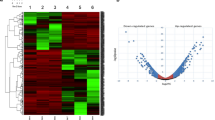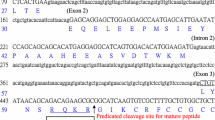Abstract
A tumor necrosis factor-alpha (TNFα)-like gene from Ciona intestinalis (CiTNFα-like) body wall challenged with bacterial lipopolysaccharide (LPS) was cloned and sequenced 4 h after LPS inoculation. An open reading frame of 936 bp encoding a propeptide of 312 amino acids (35.4 kDa) displaying a transmembrane domain from positions 7 to 29, a TACE cleavage site, and a mature peptide domain of 185 amino acids (20.9 kDa), was determined with a predicted isoelectric point of 9.4. The phylogenetic tree based on deduced amino acid sequences of invertebrate TNF-like protein and vertebrate TNFs supported the divergence between the ascidian and vertebrate TNF families, whereas D. melanogaster Eiger A and B TNF-like sequences were distinctly separated from the chordate TNFs. Thus, the ascidian TNFα-like cytokine was upregulated by in vivo LPS challenge supporting its pro-inflammatory role. In the pharynx, increased expression levels were found following analysis by real-time polymerase chain reaction, whereas in situ hybridization assay showed positive hemocytes both in the tissue and in circulating hemocytes. Finally, Western blot with monoclonal antibodies disclosed human TNFα epitopes in a 15-kDa protein component of the hemolymph serum and in a 43-kDa protein contained in the hemocyte lysate supernatant prepared in the presence of detergents. Both soluble and hemocyte-bound CiTNFα-like protein therefore appeared to be modulated by the LPS challenge.







Similar content being viewed by others
References
Akira S, Hirano T, Taga T, Kishimoto T (1990) Biology of multifunctional cytokines: IL 6 and related molecules (IL 1 and TNF). FASEB J 4:2860–2867
Ballarin L, Franchini A, Ottaviani E, Sabbadin A (2001) Morula cells as the major immunomodulatory hemocytes in ascidians: evidences from the colonial species Botryllus schlosseri. Biol Bull 201:59–64
Beck G (1998) Macrokines: invertebrate cytokine-like molecules? Front Biosci 16:559–569
Beschin A, Bilej M, Torreele E, De Baetselier P (2001) On the existence of cytokines in invertebrates. Cell Mol Life Sci 58:801–814
Beschin A, Bilej M, Lucas R, De Baetselier P (2003) Functional convergence of invertebrate and vertebrate cytokine-like molecules based on similar lectin-like activity. In: Beschin A (ed) Progress in molecular and subcellular Biology. Invertebrate cytokines. Springer, Berlin Heidelberg New York, pp 145–163
Betti M, Ciacci C, Lorusso LC, Canonico B, Falcioni T, Gallo G, Canesi C (2006) Effects of tumour necrosis factor α (TNF α) on Mytilus haemocytes: role of stress-activated mitogen-activated protein kinases (MAPKs). J Biol Cell 98:233–244
Bilej M, Joskova R, Van den Bergh R, Prochazkova P, Silerova M, Ameloot P, De Baetselier P, Beschin A (2006) An invertebrate TNF functional analogue activates macrophages via lectin-saccharide interaction with ion channels. Int Immunol 18:1663–1670
Black RA, Rauch CT, Kozlosky CJ, Peschon JJ, Slack JL, Wolfson MF, Castner BJ, Stocking KL, Reddy P, Srinivasan S, Nelson N, Boiani N, Schooley KA, Gerhart M, Davis R, Fitzner JN, Johnson RS, Paxton RJ, March CJ, Cerretti DP (1997) A metalloproteinase disintegrin that releases tumour-necrosis factor-alpha from cells. Nature 20:729–733
Bodmer JL, Schneider P, Tschopp J (2002) The molecular architecture of the TNF superfamily. Trends Biochem Sci 27:19–26
Bradford MM (1976) A rapid and sensitive method for the quantitation of microgram quantities of proteins utilizing the principles of protein–dye binding. Anal Biochem 72:248–254
De Leo G, Parrinello N, Di Bella MA (1987) Fine structure of blood system in Ciona intestinalis (Tunicata). Vessels and hemocytes in pharyngeal wall. Arch Biol 98:35–52
Delsuc F, Baurain D, Philippe H (2006) Origines des vertébrés: latunique fait-elle le moine? Med Sci 22:688–690
Ermak TH (1976) The hematogenic tissues of tunicates. In: Wright RK, Cooper EL (eds) Phylogeny of thymus and bone marrow-bursa cells. Elsevier/North-Holland, Amsterdam, pp 45–56
Field KG, Olsen GJ, Giovannoni SJ, Ghiselin MT, Raff EC, Pace NR, Raff RA (1988) Molecular phylogeny of the animal kingdom. Science 239:748–753
Franchini A, Miyan JA, Ottaviani E (1996) Induction of ACTH- and TNFα-like molecules in the hemocytes of Calliphora vomitoria (Insecta Diptera). Tissue Cell 5:587–592
Goetz FW, Planas JV, MacKenzie S (2004) Tumor necrosis factors. Dev Comp Immunol 28:487–497
Hori H, Osawa S (1987) Origin and evolution of organisms as deduced from 5S ribosomal RNA sequences. Mol Biol Evol 5:445–472
Hughes TK, Smith EM, Chin R, Cadet P, Sinisterra J, Leung MK, Shipp MA, Scharrer B, Stefano GB (1990) Interaction of immunoactive monokines (interleukin 1 and tumor necrosis factor) in the bivalve mollusc Mytilus edulis. Proc Natl Acad Sci USA 87:4426–4429
Idriss TH, Naismith JH (2000) TNF alpha and the TNF receptor superfamily: structure function relationship(s). Microsc Res Tech 1:184–195
Käll L, Krogh A, Sonnhammer EL (2004) A combined transmembrane topology and signal peptide prediction method. J Mol Biol 14:1027–1036
Kiraga J, Mackiewicz P, Mackiewicz D, Kowalczuk M, Biecek P, Polak N, Smolarczyk K, Dudek MR, Cebrat S (2007) The relationships between the isoelectric point and length of proteins, taxonomy and ecology of organisms. BMC Genomics 12:8–163
Laemmli UK (1970) Cleavage of structural protein during the assembly of the head of bacteriophage T4. Nature 227:680–685
Le Guellec D (1998) Ultrastructural in situ hybridization: a review of technical aspects. Biol Cell 90:297–306
MacKenzie S, Planas JV, Goetz FW (2003) LPS-stimulated expression of a tumor necrosis factor-alpha mRNA in primary trout monocytes and in vitro differentiated macrophages. Dev Comp Immunol 27:393–400
Magor BG, Magor KE (2001) Evolution of effectors and receptors of innate immunity. Dev Comp Immunol 25:651–682
Mahoney R (1973) Laboratory techniques in zoology. Butterworth, London
Mazzi V (1977) Manuale di tecniche istologiche e istochimiche. Piccin, Padua
Mijatovic T, Houzet L, Defrance P, Droogmans L, Huez G, Kruys V (2000) Tumor necrosis factor-alpha mRNA remains unstable and hypoadenylated upon stimulation of macrophages by lipopolysaccharides. Eur J Biochem 267:6004–6012
Moreno E, Yan M, Basler K (2002) Evolution of TNF signaling mechanisms: JNK-dependent apoptosis triggered by Eiger, the Drosophila homolog of the TNF superfamily. Curr Biol 12:1263–1268
Nicholas KB, Nicholas Jr HB (1997) GeneDoc: analysis and visualization of genetic variation. Available from: http://www.cris.com~ketckup/genedoc.shtml
Olivares Fontt EA, Becshin E, Van Dijck V, Vercruysse M, Bilej R, Lucas P, De Baetselier B, Vray B (2002) Trypanosoma cruzi is lysed by coelomic cytolytic factor-1, an invertebrate analogue of tumor necrosis factor, and induces phenoloxidase activity in the coelomic fluid of Eisenia foetida foetida. Dev Comp Immunol 26:27–34
Ordás MC, Costa MM, Roca FJ, López-Castejón G, Mulero V, Meseguer J, Figueras A, Novoa B (2007) Turbot TNFalpha gene: molecular characterization and biological activity of the recombinant protein. Mol Immunol 44:389–400
Ouwe-Missi-Oukem-Boyer O, Porchet E, Capron A, Dissous C (1994) Characterization of immunoreactive TNFα molecules in the gastropod Biomphalaria glabrata. Dev Comp Immunol 18:211–218
Parrinello N (1996) Cytotoxic activity of tunicates hemocytes. In: Muller WEG, Rinkevich B (eds) Cellular, biochemical and molecular aspects of invertebrate immunology. Progress in molecular and subcellular biology. Springer, Berlin Heidelberg New York, pp 190–217
Parrinello N, Patricolo E, Canicattı C (1984a) Inflammatory-like reaction in the tunic of Ciona intestinalis (Tunicata). Encapsulation and tissue injury I. Biol Bull 167:229–237
Parrinello N, Patricolo E, Canicattı C (1984b) Inflammatory-like reaction in the tunic of Ciona intestinalis (Tunicata). Encapsulation tissue injury II. Biol Bull 167:238–250
Parrinello N, Arizza V, Cammarata M, Giaramita FT, Pergolizzi M, Vazzana M, Vizzini A, Parrinello D (2007) Inducible lectins with galectin properties and human IL1α epitopes opsonize yeast during the inflammatory response of the ascidian Ciona intestinalis. Cell Tissue Res 329:379–390
Pfeifer K, Schröder HC, Rinkevich B, Uhlenbruck G, Hanisch FG, Kurelec B, Scholz P, Müller WE (1992) Immunological and biological identification of tumour necrosis-like factor in sponges: endotoxin that mediates necrosis formation in xenografts. Cytokine 4:161–169
Pinto MR, Chinnici CM, Kimura Y, Melillo D, Marino R, Spruce LA, De Santis R, Parrinello N, Lambris JD (2003) CiC3–1a mediated chemotaxis in the deuterostome invertebrate Ciona intestinalis (Urochordata). J Immunol 171:5521–5528
Praveen K, Evans DL, Jaso-Friedmann L (2006) Constitutive expression of tumor necrosis factor-alpha in cytotoxic cells of teleosts and its role in regulation of cell-mediated cytotoxicity. Mol Immunol 43:279–291
Rink L, Kirchner H (1996) Recent progress in the tumor necrosis factor-alpha field. Int Arch Allergy Immunol 111:199–209
Rowley AF (1981) The blood cells of the sea squirt, Ciona intestinalis: morphology, differential count, and in vitro phagocytic activity. J Invertebr Pathol 37:91–100
Schwartz R, Ting CS, King J (2001) Whole proteome pI values correlate with subcellular localizations of proteins for organisms within the three domains of life. Genome Res 11:703–709
Shida K, Terajima D, Uchino R, Ikawa S, Ikeda M, Asano K, Watanabe T, Azumi K, Nonaka M, Satou Y, Satoh N, Satake M, Kawazoe Y, Kasuya A (2003) Hemocytes of Ciona intestinalis express multiple genes involved in innate immune host defense. Biochem Biophys Res Commun 302:207–218
Silerova M, Prochazkova P, Joskova R, Josens G, Beschin A, De Baetselier P, Bilej M (2006) Comparative study of the CCF-like pattern recognition protein in different lumbricid species. Dev Comp Immunol 30:765–771
Swalla BJ, Cameron CB, Corley LS, Garey JR (2000) Urochordates are monophyletic within the deuterostomes. Syst Biol 49:52–64
Terajima D, Shida K, Takada N, Kasuya A, Rokhsar D, Satoh N, Satake M, Wang HG (2003) Identification of candidate genes encoding the core components of the cell death machinery in the Ciona intestinalis genome. Cell Death Differ 10:749–753
Thompson JD, Higgins DG, Gibson TJ (1994) Clustal W: improving the sensitivity of progressive multiple sequence alignment through sequence weighting, position-specific gap penalties and weight matrix choice. Nucleic Acids Res 22:4673–4680
Thompson JD, Gibson TJ, Plewniak F, Jeanmougin F, Higgins DG (1997) The CLUSTAL_X windows interface: flexible strategies for multiple sequence alignment aided by quality analysis tools. Nucleic Acids Res 25:4876–4882
Vizzini A, Pergolizzi M, Vazzana M, Salerno G, Di Sano C, Macaluso P, Arizza V, Parrinello D, Cammarata M, Parrinello N (2008) FACIT collagen (1alpha-chain) is expressed by hemocytes and epidermis during the inflammatory response of the ascidian Ciona intestinalis. Dev Comp Immunol 32:682–692
Wittwer D, Franchini A, Ottaviani E, Wiesner A (1999) Presence pf IL-1 and TNF-like molecules in Galleria mellonella (Lepidoptera) haemocytes and in insect cell line from Estigmene acraea (Lepidoptera). Cytokine 11:637–642
Zeng L, Swalla BJ (2005) Molecular phylogeny of the protochordates: chordate evolution. Can J Zool 83:24–33
Acknowledgements
We thank Mr. G. Miceli for collecting ascidians, and Mr. M. Guarcello for expert maintenance of the aquaria.
Author information
Authors and Affiliations
Corresponding author
Additional information
This work was supported by a research grant from the Italian Ministry of University and Scientific Research (PRIN 2006 to N. Parrinello), co-funded by the University of Palermo.
Rights and permissions
About this article
Cite this article
Parrinello, N., Vizzini, A., Arizza, V. et al. Enhanced expression of a cloned and sequenced Ciona intestinalis TNFα-like (CiTNFα) gene during the LPS-induced inflammatory response. Cell Tissue Res 334, 305–317 (2008). https://doi.org/10.1007/s00441-008-0695-4
Received:
Accepted:
Published:
Issue Date:
DOI: https://doi.org/10.1007/s00441-008-0695-4




